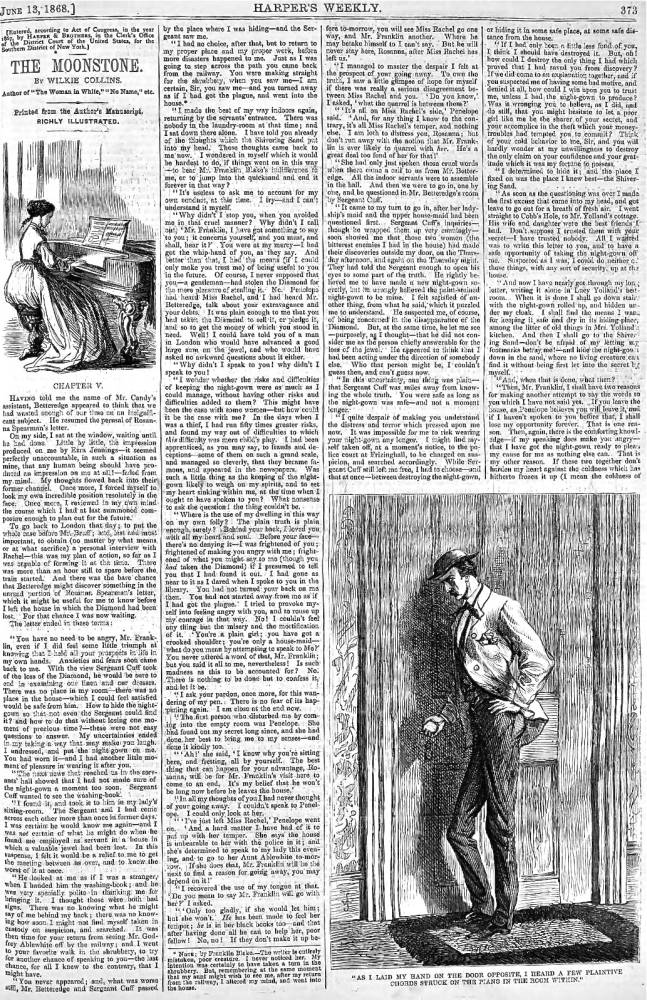

[Rachel Verinder at the piano, in Mr. Bruff's conservatory at his home in Hampstead] — Wilkie Collins's The Moonstone: A Romance: "Second Period, Third Narrative, Contributed by Franklin Blake," uncaptioned headnote vignette for Chapter VI, the twenty-second such vignette. The twenty-fourth instalment in Harper's Weekly (13 June 1868), page 373. Wood-engraving, 9 x 5.5 cm., located at the head of the sixth chapter in the first volume edition, p. 164. [The Harper & Bros. house illustrator contrasts the demure socialite Rachel Verinder, heir to a vast estate, with the housemaid Rosanna Spearman, seen in the previous week's headnote vignette.]
Scanned images and text by Philip V. Allingham. Illustrations courtesy of the E. J. Pratt Fine Arts Library, University of Toronto, and the Irving K. Barber Learning Centre, University of British Columbia. [You may use these images without prior permission for any scholarly or educational purpose as long as you (1) credit the Universities of Toronto and British Columbia and (2) link your document to this URL in a web document or cite The Victorian Web in a print one.]
Passage suggested by the Headnote Vignette for the Twenty-fourth Instalment
I crumpled up the letter [from Rosanna Spearman] in my pocket, and forgot it the moment after, in the all-absorbing interest of my coming interview with Rachel.
As the clock of Hampstead church struck three, I put Mr. Bruff's key into the lock of the door in the wall. When I first stepped into the garden, and while I was securing the door again on the inner side, I own to having felt a certain guilty doubtfulness about what might happen next. I looked furtively on either side of me; suspicious of the presence of some unexpected witness in some unknown corner of the garden. Nothing appeared, to justify my apprehensions. The walks were, one and all, solitudes; and the birds and the bees were the only witnesses.
I passed through the garden; entered the conservatory; and crossed the small drawing-room. As I laid my hand on the door opposite, I heard a few plaintive chords struck on the piano in the room within. She had often idled over the instrument in this way, when I was staying at her mother's house. I was obliged to wait a little, to steady myself. The past and present rose side by side, at that supreme moment — and the contrast shook me.
After the lapse of a minute, I roused my manhood, and opened the door. — "Second Period, Third Narrative,Contributed by Franklin Blake," tail end of Chapter 6, p. 376.
Commentary: Complementary Perceptions and Narratives
The Harper's illustrations that bookend the twenty-fourth instalment (Rachel at the piano, Franklin at the door) are complementary, representing both sides of what lies on the doorway or threshold described at the very end of the instalment: inside the conservatory, Rachel is at the pianoforte; just outside the conservatory, returned from abroad and armed with the knowledge of what was hidden in Rosanna Spearman's box, Franklin Blake is about to use Mr. Bruff's key and confront Rachel about why she believes he stole the Diamond. Each perspective is true and correct, but each is incomplete as a realisation of the three concluding paragraphs. Although the entire instalment separates the two illustrations, in fact the physical distance between Rachel and Franklin at this point is slight. Nevertheless, by virtue of the differing scales of the two wood-engravings, the emphasis seems to be on Franklin Blake's feelings and perceptions rather than Rachel's feelings. As we reach the climax of the instalment, Franklin Blake is about to open the door; but this serial curtain forces the reader to purchase the next week's instalment (20 June 1868) in order to discover what kind of reception he will receive and whether the couple, combining their memories of the night of Rachel' birthday, will discover the truth about the disappearance of the Moonstone.
The Harper'sillustrators also repeatedly deploy threshold settings, locating Collins’s characters near doors or windows. These thresholds, we argue, visually suggest the sensation genre’s propensity for disrupting boundaries of gender and class, as well as this particular novel’s violation of barriers between the known and the unknown, white and nonwhite, England and its foreign others, law and desire, the conscious and the unconscious. The illustrations show Rachel watching the man she loves steal her gemstone (chapter head, Part 25); Rachel watching the investigation and wishing that Franklin might escape (Part 6, fig. 7); and Franklin sleepwalking, midway between conscious and unconscious states (chapter head, Part 30). All of these events place characters in positions where their conscious ethics and their basic drives collide, suggesting how the novel presses beyond the surface of identity, probing its margins. The illustrations contribute, then, to the novel’s status as sensation fiction, suggesting the text's roiling undercurrents, its deep-set fears of colonial invasion at the heart of England, and its capacity to undermine or cross boundaries fundamental to self and social identities.— Surridge and Leighton, p. 222.
Related Materials
- The Moonstone and British India (1857, 1868, and 1876)
- Detection and Disruption inside and outside the 'quiet English home' in The Moonstone
- George Du Maurier, "Do you think a young lady's advice worth having?" — p. 94.
- Illustrations by F. A. Fraser for Wilkie Collins's The Moonstone: A Romance (1890)
- Illustrations by John Sloan for Wilkie Collins's The Moonstone: A Romance (1908)
- Illustrations by Alfred Pearse for The Moonstone: A Romance (1910)
- The 1944 illustrations by William Sharp for The Moonstone (1946).
Last updated 1 December 2016